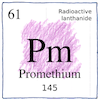Oak Ridge—Charles D. Coryell,
Jacob A. Marinsky,
Lawrence E. Glendenin
elements

|
Promethium
Element 61 couldn’t be found in nature, but scientists working for the Manhattan Project had plenty of unnatural materials at hand. The purpose of the reactor at Oak Ridge was to irradiate uranium slugs to produce plutonium. A ton of uranium slugs from the reactor went to the chemical-separation building every three days. After separating the plutonium, scientists found they had created many other radioactive materials, including an element with an atomic weight of 61 that Coryell’s wife suggested naming after Prometheus.
Atomic number 61
Promethium-147 emits beta particles; it doesn’t emit alpha or gamma rays so it’s relatively safe, used in luminous paint, in betavoltaic devices for spacecraft and pacemakers, and for measuring the thickness of materials.
No mineral contains promethium
Chemists in the 1920s wasted their time and reputation trying to isolate element 61 from rare-earth minerals. It wasn’t there. A gap in the table between neodymium and samarium might have suggested it would be difficult to isolate, but it wasn’t there.
Daring and danger
He stole fire from Mount Olympus and gave it to mankind. So Zeus has him chained to a rock where an eagle eats his heart.



Many people concentrate on a good or potential good of a new power, and think they can control its dangers.
See also in The book of science:
Readings in wikipedia:
Other readings: